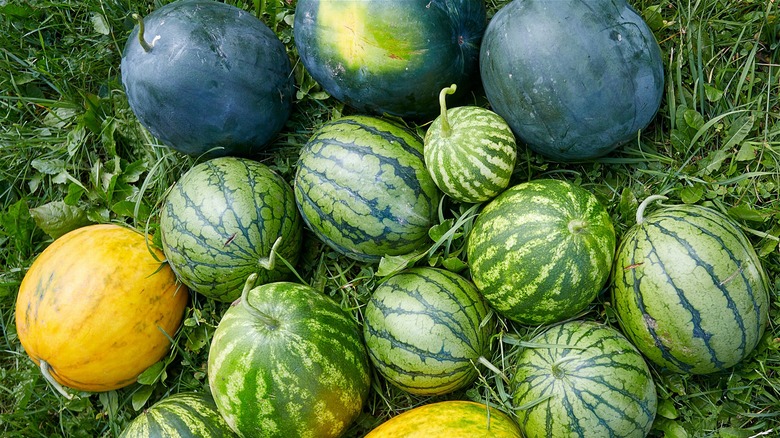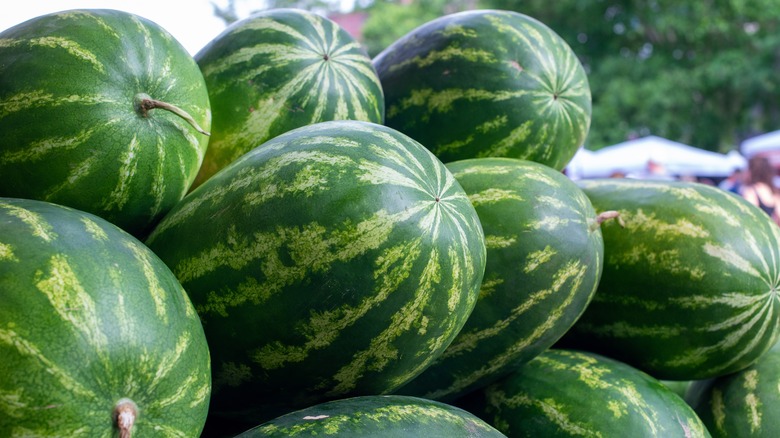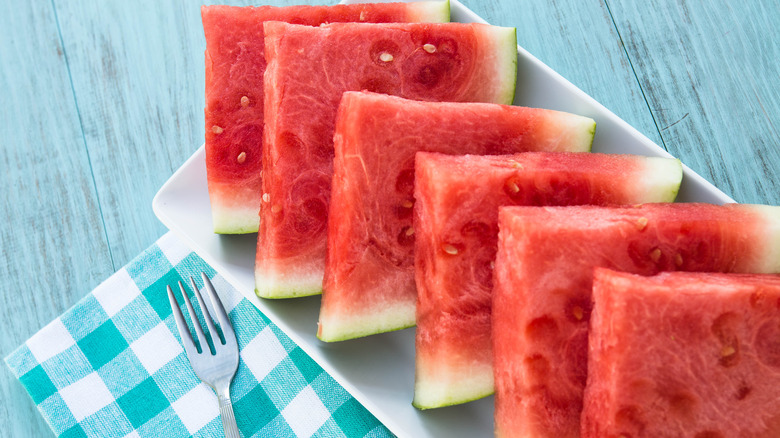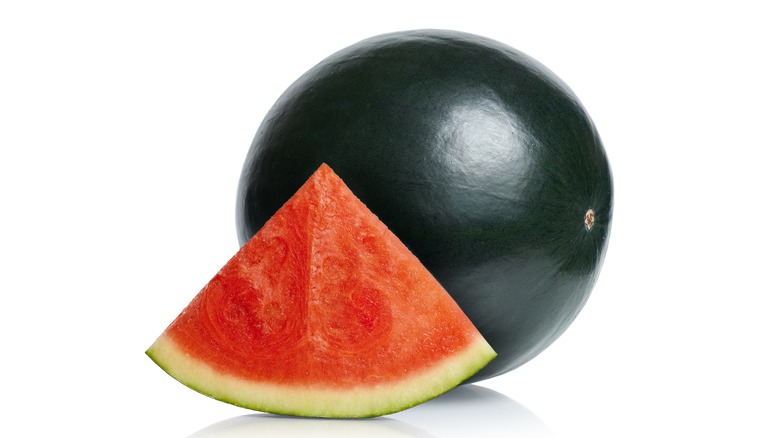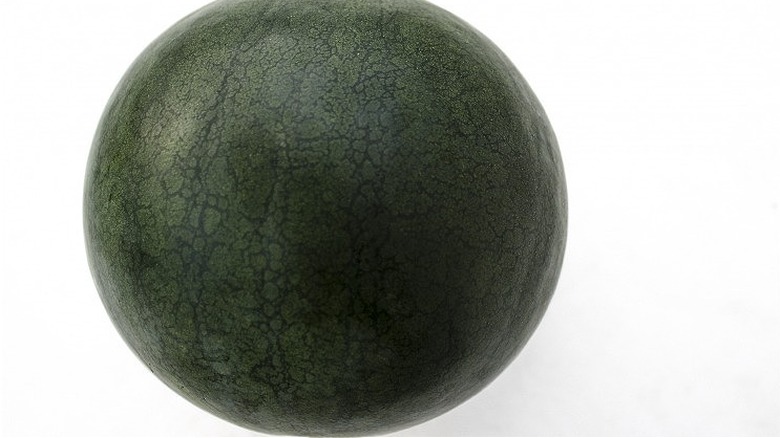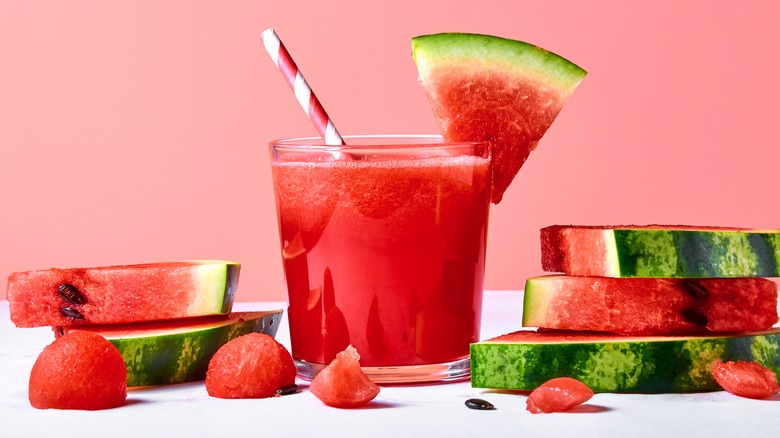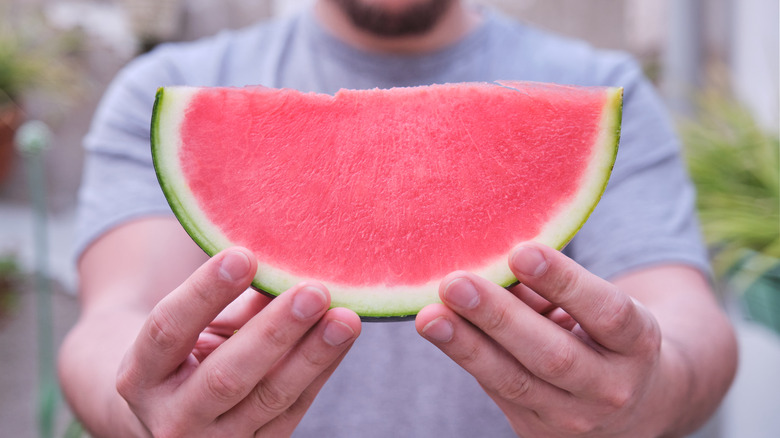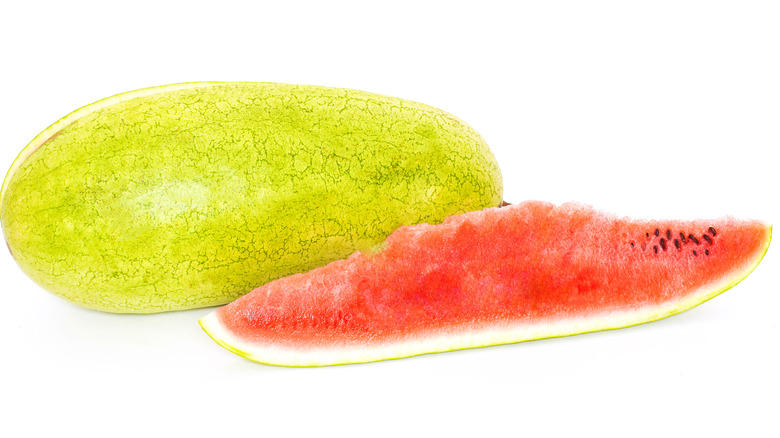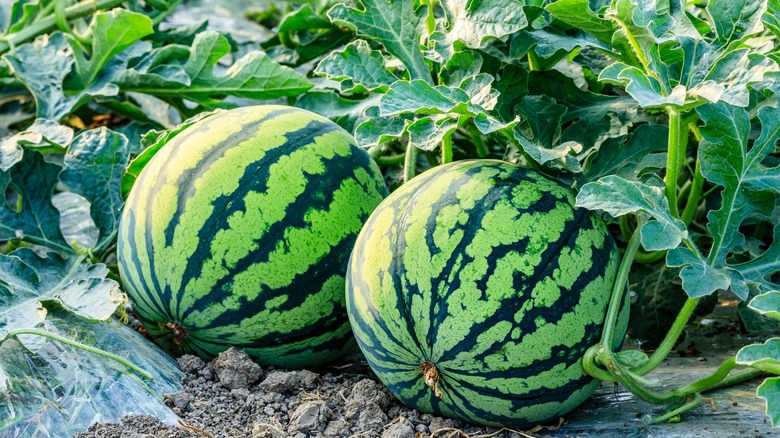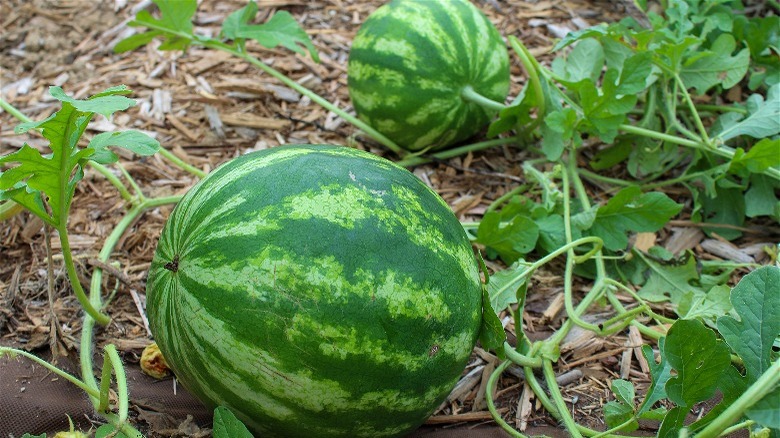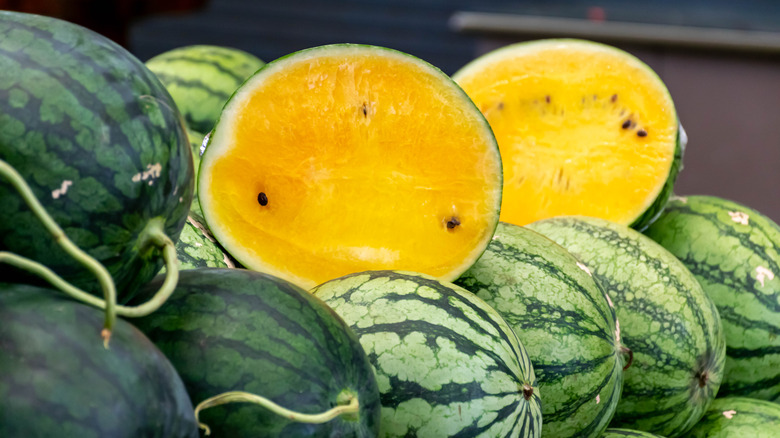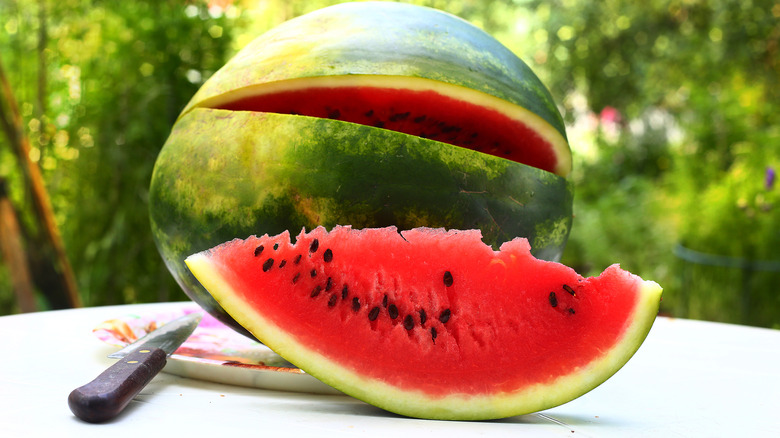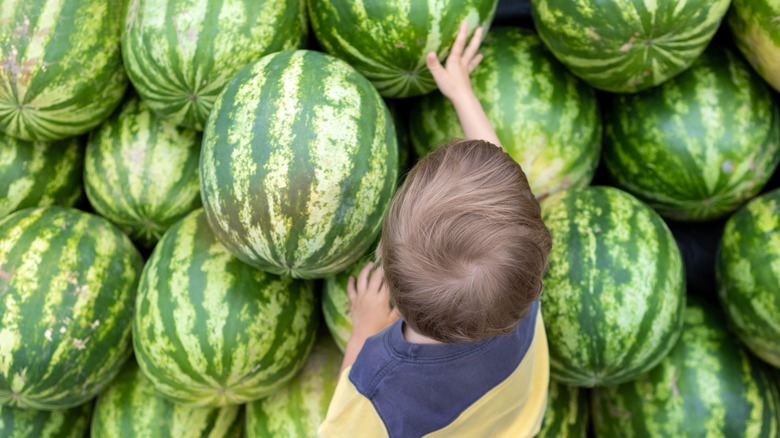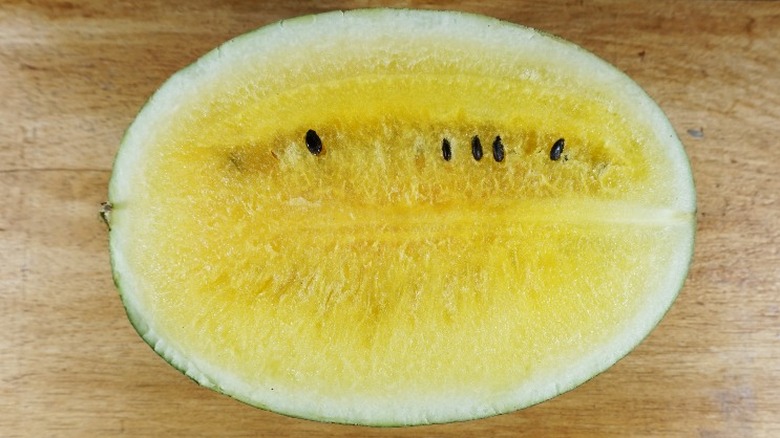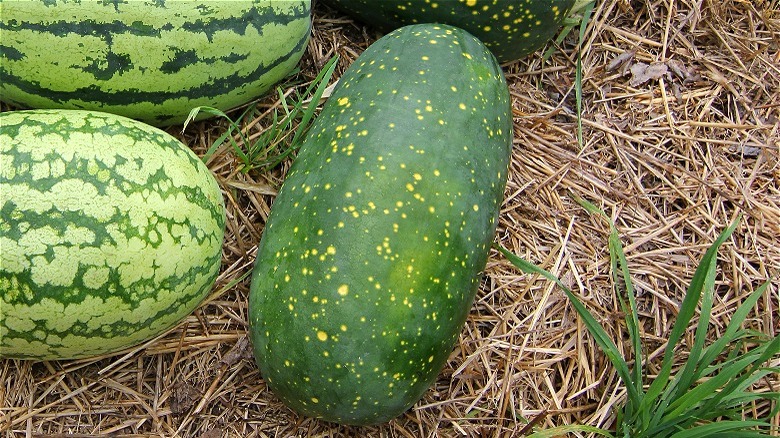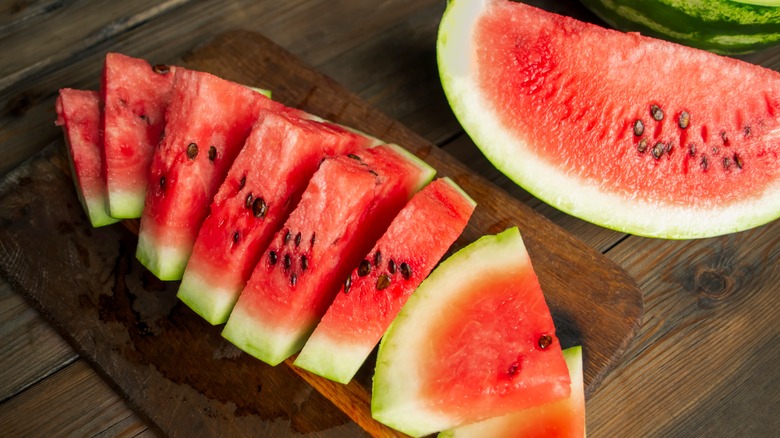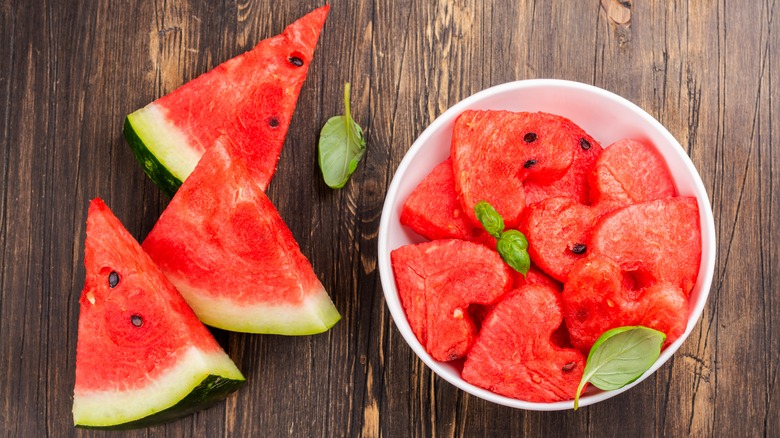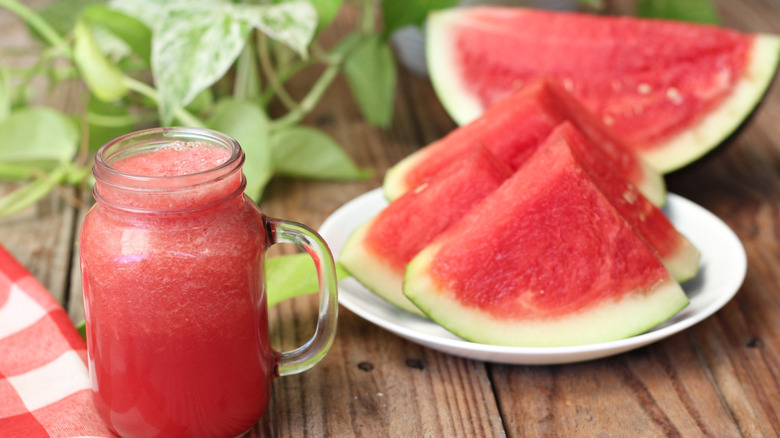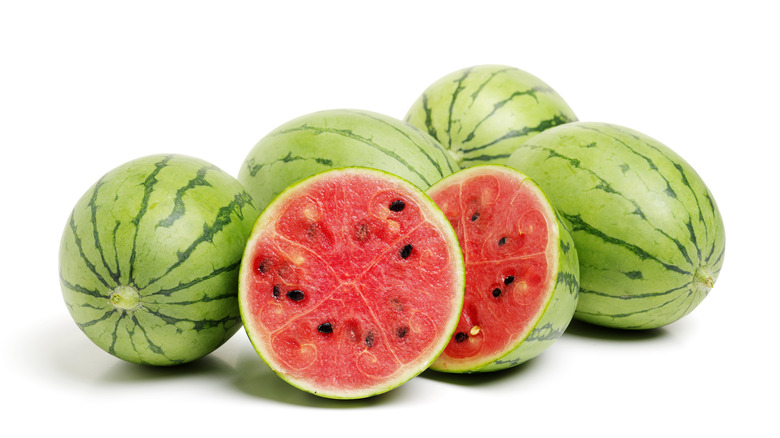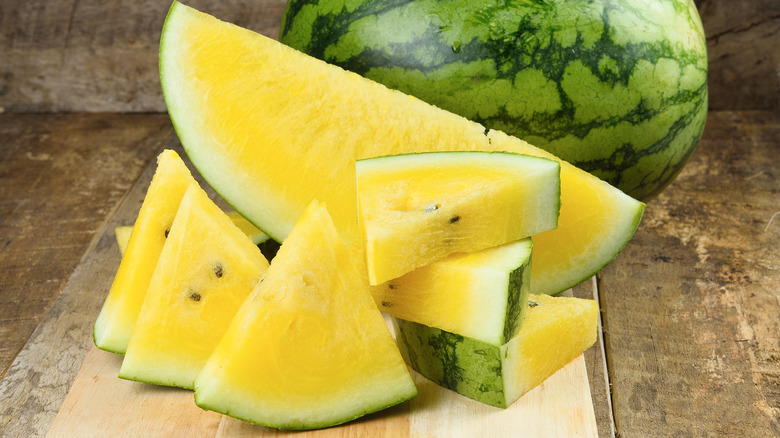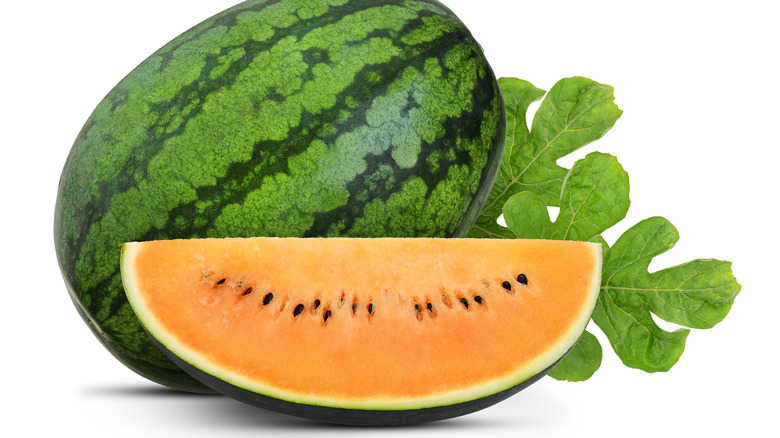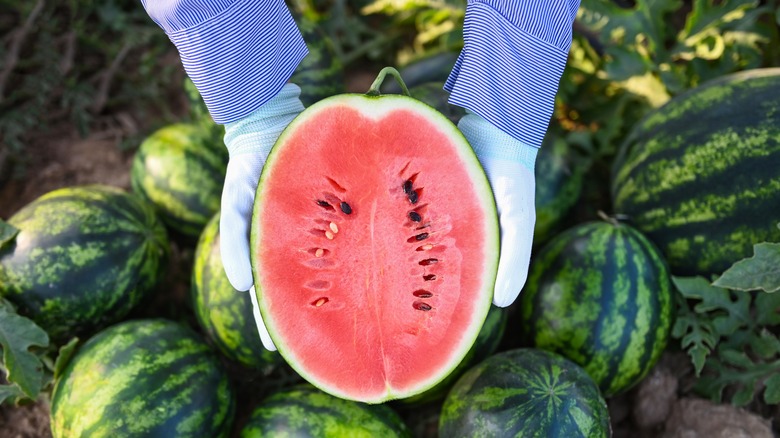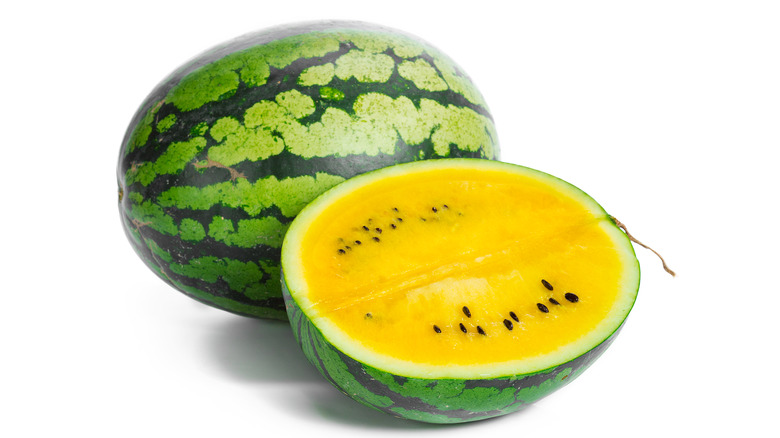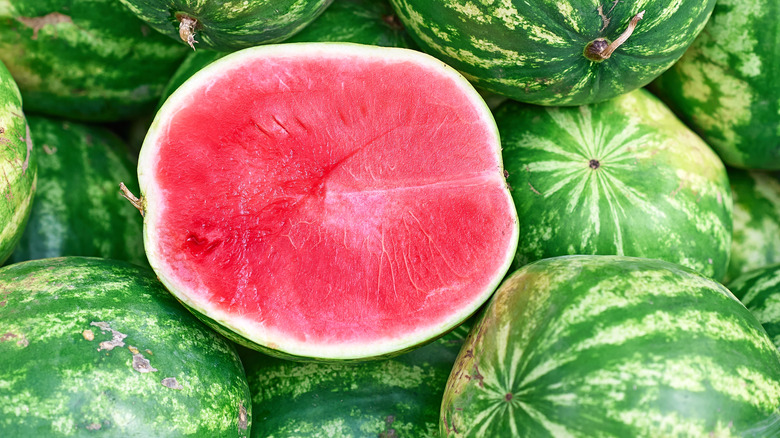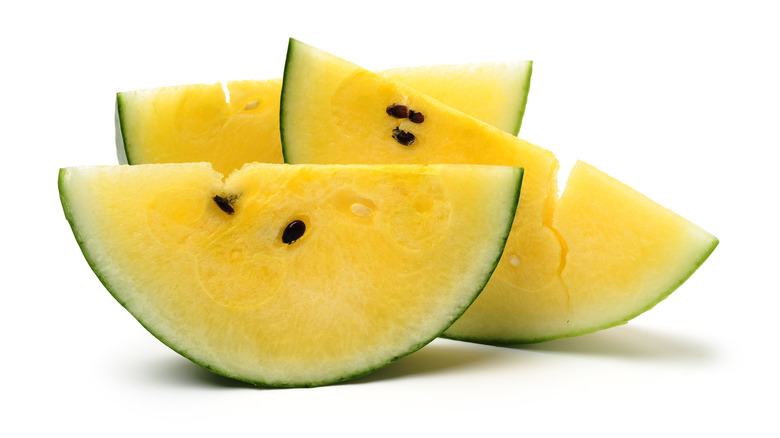A Beginner's Guide To Watermelon Varieties
Snacking on a juicy piece of watermelon can be so refreshing on a hot summer day. The fruit tastes delicious on its own, whether cubed or eaten directly off of the rind. It can also make the perfect addition to a fruit salad during cookouts with friends and family. You can even use watermelon in a wide variety of other recipes, including smoothies, salads, salsas, frozen treats, and cocktails.
You may have noticed that some watermelons have black seeds, while others are seedless. But you probably didn't know that there are actually more than 300 different types of watermelon grown in the United States.
These different types can vary significantly in size. Some weigh around 1 pound, while others can weigh as much as 40 each. These watermelon types may also come in different shapes, be seeded or seedless, or have different colored flesh. Read on to learn more about some of the many varieties of watermelon you may be able to grow in your own backyard or find at your local farmer's market.
Allsweet
This watermelon's name says it all. The Allsweet watermelon offers a delicious flavor that is sure to delight your taste buds. It is a type of heirloom watermelon that was developed at the University of Kansas by Dr. Hall, who invented the Allsweet while looking to create a sister watermelon to the Crimson Sweet, another tasty variety.
Once they are ready to be harvested, Allsweet watermelons often weigh around 30 pounds. They have an oblong shape with a striped rind and bright red flesh. While the taste of this watermelon is pretty spectacular, its texture is less firm than some other varieties. This means that it isn't ideal for balling or creating formed pieces. They are, however, an excellent choice when making smoothies and watermelon cocktails. If you're looking for a watermelon that you can grow in your own backyard, the Allsweet may not be the best choice for you. Seeds for it are typically only available for commercial use.
Big Tasty
If you're looking to try a newer watermelon variety that is turning out to be a favorite, look no further than the Big Tasty. This variety can also be a good choice if you prefer seedless watermelons, as the Big Tasty does not contain any seeds. The watermelon has a sweet taste with a firm and crunchy texture. These qualities have helped the Big Tasty to win awards for its flavor.
This type of watermelon is moderately sized and classified as an icebox watermelon. Icebox watermelons are generally smaller than heirloom watermelons. They generally weigh between 6 and 8 pounds, making them easier to carry than larger melon types.
The Big Tasty's inner flesh is that classic deep red color, but its outer rind is less typical. This exterior has a lighter, greenish-gray color. These watermelons can be used in a variety of recipes or eaten straight off the rind. Its flavor even holds better than some other varieties, meaning you can cut and store the melon for a bit longer before using it all up.
Blacktail Mountain
The Blacktail Mountain watermelon has a crunchy and sweet red flesh. Its outer ring is very dark green, almost black in color, hence its name. This variety of watermelon was developed at the Sand Hill Preservation Center in Iowa by Glenn Drowns.
Because of its ability to grow in extremely hot conditions, it's versatile enough to be grown in diverse climates. It is also a favorite in northern areas of the country, where it matures quickly. Blacktail Mountain watermelons are round, can weigh between 3 and 12 pounds, and are about 8 to 9 inches long.
Bush Sugar Baby
The Bush Sugar Baby is a type of icebox watermelon that typically weighs between 6 and 12 pounds. Icebox watermelons are named for their smaller size, which makes them easier to fit in the refrigerator than larger melons.
These watermelons have a deep pink to red flesh, which comes dotted with black seeds. Their rind is a solid dark green, lacking the stripes that several other watermelon varieties have.
This fruit has a high sugar concentration, making it very sweet. Its flesh is also firm and crisp, making it good for balling and several other applications. Whether you're looking for a watermelon to slice and serve at a summer barbecue, you want to make fruit salad, or you'd like to prepare a watermelon smoothie, the Bush Sugar Baby could come in handy.
Calsweet
Calsweet watermelons may be round or oval in shape, with firm red flesh, black seeds, and a sweet and juicy flavor. The outer rind of a Calsweet is dark green with stripes. They typically weigh between 10 and 12 pounds each.
If you are short on space and are looking to grow your own watermelon, the Calsweet can be an excellent choice. Compared to other varieties, its vines are much more compact, only growing to be up to 18 inches long. Even with its smaller vines, each plant yields between two and three melons within 90 days or 65 days from a transplant.
Captivation
The Captivation is another watermelon variety for those who don't like seeds. The fruit is ideal for slicing and snacking or adding to your favorite fruit salad recipe. They weigh 14 to 17 pounds each and are oval in shape.
The Captivation has a darker green rind, but once they are ready to be picked, the rind color fades a bit. The inner flesh of a Captivation is crunchy and red. However, this color is lighter than the one you'll find in other varieties. If you're planning to plant Captivation watermelon seeds in your home garden, expect them to take 89 days to mature.
Charleston Gray
When you first see a Charleston Gray watermelon, you may be unimpressed by its appearance. This fruit has an oblong shape, with a light green to gray rind. It noticeably lacks the stripes that you see on many other watermelon varieties.
However, once you cut into the Charleston Gray watermelon and taste it, you'll quickly fall in love with this melon. Without the fibrous texture that some other watermelons have, the Charleston Gray is quite enjoyable. Even its seeds can't distract from its sweet and juicy taste. This fruit can be the perfect addition to watermelon salads, fruit salads, and so much more.
This type of watermelon is quite large. Most weigh at least 20 pounds, with some weighing up to 40 pounds. The melon was developed nearly 70 years ago by C.F. Andrus, who was working for the United States Department of Agriculture, helping the USDA to make watermelons that would be more resistant to diseases.
Cream of Saskatchewan
Another watermelon variety you might want to taste, or even grow in your garden, is the Cream of Saskatchewan. This variety can thrive in warm and cold climates, making it a good choice for growers across the country. It is believed that this watermelon variety was first grown in Russia before being brought to Canada, then later to the United States.
The Cream of Saskatchewan watermelon has a much paler inner flesh than you'll find with most other melons. It may be pale yellow or nearly white in color. It is not a seedless variety.
These melons are crispy and relatively sweet. They can also be easily identified by their rind, which has dark green stripes against a brighter green background color. The rind is also much thinner than that of many other melons. Most Cream of Saskatchewan melons weigh between 5 and 10 pounds each.
Crimson Sweet
The Crimson Sweet watermelon was created in 1963 at Kansas State University. It is a large, oval-shaped melon that can weigh between 15 and 25 pounds. These watermelons have a dark green rind with lighter green stripes. When you cut into one of these melons, you'll find its flesh to be dark red in color. This is a seeded variety, so you'll also see the characteristic black watermelon seeds.
This type of watermelon can be a good choice for home gardeners because it is relatively easy to grow. It was also developed to be resistant to many diseases, making it easier to have success growing this crop.
However, unless you have a large garden area, it may not be the best choice for your backyard. Between the larger vines that may grow to be up to 8 feet long and the heftier size of the melons themselves, the Crimson Sweet isn't a suitable choice for smaller garden beds.
Desert King
With its inner yellow flesh, the Desert King is an especially unique-looking watermelon. The seeds of this watermelon also look a bit different, since they come in a grayish-black color. Also, the outer rind of the fruit is on the thinner side. This rind is light green in color. Even if it doesn't look like the watermelons you're used to, the taste of Desert King watermelons won't disappoint. It is very sweet and juicy.
Desert King watermelons grow best in full sun. They do not require a lot of water. They are considered a drought-resistant variety, hence the name. A Desert King watermelon can weigh up to 40 pounds, but many are closer to 20 pounds.
Florida Giant
As you can probably guess by their name, Florida Giant watermelons are quite large. Most weigh about 50 pounds, but some can grow to weigh as much as 90 pounds. This hybrid variety was the result of crossbreeding seeds from a Bradford watermelon and a Georgia Rattlesnake watermelon. This pairing gives the Florida Giant watermelon a deliciously sweet flavor.
Florida Giant watermelons are a relatively popular variety due to their exceptional flavor and texture. They have bright red flesh with black seeds, along with a dark green and subtly-striped rind. There are so many different ways you can use a Florida Giant watermelon — from snacking to making frozen treats like these Watermelon Cooler Pops.
Georgia Rattlesnake
Georgia Rattlesnake watermelons — one of the fruits from which the Florida Giant watermelon was created — are a bit smaller than their offspring. They generally grow to weigh about 35 pounds, but some have been known to get even bigger.
This type of watermelon has a thick and solid rind, which allows for safer and easier transport and storage than some other varieties. This rind is decorated with dark green and white-green stripes. This fruit also has a crisp, pink-red flesh that contains black seeds, perfect for a refreshing treat on a hot day. It is a type of heirloom watermelon that was first developed in the 1830s.
Gold in Gold
Gold in Gold is the perfect name for this watermelon. It has a yellow rind that surrounds the golden flesh. This is a seeded watermelon variety, so the dark black seeds really stand out against the bright gold flesh.
This type of watermelon has a high sugar content, giving it a distinctly sweet taste. Most Gold in Gold watermelons weigh between 11 and 16 pounds.
There are many ways to enjoy the Gold in Gold watermelon, beyond eating it straight off the rind. It can help add some color to a fruit salad. You could also pair it with ingredients like olive oil, burrata, and tomatoes to make a savory salad.
Harvest Moon
Harvest Moon watermelons are a seedless hybrid heirloom variety. They have pink-red flesh with a spectacularly juicy flavor. The melons weigh between 18 and 20 pounds and have a dark green rind. The rind is speckled with yellow spots.
If you're looking for a watermelon you can grow in your backyard, the Harvest Moon is a good variety to consider. It offers much more compact vines, while each plant still produces four or five melons. The melon is also able to tolerate very hot conditions. However, it does require full sun and moist soil.
Jubilee
Jubilee watermelons are a disease-resistant variety, making them a good choice for home gardeners. They grow best in full sun, and take about 95 days to mature, which is longer than many varieties. This type of melon should be started inside, before being transferred to outside soil after about a month. It is important to make sure that the soil is at least 70 degrees before moving the young plants.
This type of melon is on the larger side, often weighing 25 pounds or more each. Their rind is a lighter green color, with dark green stripes. The flesh of a Jubilee watermelon is bright red, sweet, and crisp. It has several black seeds.
Klondike Blue Ribbon Striped
If you're looking for a sweet watermelon to serve at your next backyard picnic, look no further than the Klondike Blue Ribbon Striped watermelon. With its higher sugar content, this melon offers a delicious flavor, perfect for enjoying straight off the rind. Of course, you could also add it to your favorite fruit salad recipe, combine it with other fruits for smoothies, and more.
First developed in 1939, Klondike Blue Ribbon Striped watermelons are a medium-sized variety, with most weighing between 20 to 30 pounds. They are also known to be disease-resistant.
The watermelon comes with a thin, coarse rind that's decorated with dark and light green stripes. When you cut into a Klondike Blue Ribbon Striped watermelon, you'll find it's filled with firm and deep red flesh.
Millionaire
If you prefer seedless watermelons, then you'll probably think that the Millionaire tastes like a million bucks! This hybrid watermelon variety can grow to between 15 and 22 pounds. It has a hard, thick rind with green stripes and a pink-red inner flesh. With the flesh's firmer texture, Millionaire watermelons are crisp and ideal for snacking and slicing for a variety of recipes. Compared to other melon varieties, Millionaire watermelons are also less likely to have separated flesh on the inside.
Another benefit associated with Millionaire watermelons is that they have a strong vine. The vine is better able to resist diseases, such as Fusarium and Anthracnose, that can plaque other melons.
Mini Love
The Mini Love is another award-winning watermelon. As its name implies, it is a smaller variety, usually weighing only 7 to 9 pounds. They may be either round or oval in shape. Each melon has a dark green rind with lighter green stripes. The best thing about the Mini Love watermelon is the juicy and sweet taste that its dark red flesh delivers.
This type of watermelon can be a good option for home gardens. The vines of Mini Love watermelons are much smaller than many other varieties. In fact, the vines are so compact that you could even potentially grow them on your deck or patio. Additionally, the plant is resistant to diseases. It can even yield up to six watermelons on each vine.
Mountain Sweet Yellow
From the outside, a Mountain Sweet Yellow watermelon looks like many others, since it has a darker green rind with lighter green stripes. However, the melon's shape is oblong, rather than the round or oval shape you'll see with many other varieties. When you cut into a Mountain Sweet Yellow watermelon, you'll certainly notice something that you don't see with most other watermelons: yellow flesh. The flesh may be different shades of yellow, but it will definitely not be the classic red associated with watermelons.
Like many other yellow watermelons, Mountain Sweet Yellows are especially sweet. Some even describe them as tasting like honey. With its sugar-filled taste, there are a lot of ways you can use a Mountain Sweet Yellow watermelon. It can be perfect for making frozen desserts.
Orange Crisp
Orange Crisp watermelons are another variety that doesn't look how you'd expect. Instead, these melons have a bright orange inner flesh with a delectably sweet flavor. The flesh is firm and crisp, making it perfect for balling, slicing, and more. An Orange Crisp is also known to hold its sweet flavor once cut, allowing you to store it for longer before having to use it all up.
Orange Crisp watermelons grow to be 14 to 18 pounds. They have a decently thick dark green rind, with lighter green stripes. The contrast between the orange flesh color and green rind makes this variety look attractive when sliced and served.
Sweet Princess
The Sweet Princess watermelon is a hybrid variety that was developed at the Agriculture Experiment Station in Raleigh, North Carolina. These melons are oblong with a light green or yellow rind. Compared to many other watermelon varieties, which have a rind decorated with stripes, the Sweet Princess has more of a marbled pattern. Inside this rind is red-pink flesh sprinkled with black seeds.
These watermelons can weigh anywhere from 20 to 30 pounds. Heavier melons are known for delivering the juiciest flavors. You can enjoy this melon with any of your favorite watermelon recipes. However, it's important to note that its flavor works especially great in spicy dishes.
Tendergold
Tendergold watermelons have juicy and delicious yellow flesh. When at their peak, their flesh is a yellow-orange color with a sweet taste. Relatively large black seeds are mixed in with this yellow flesh. The rind surrounding the beautiful yellow flesh is deep green with lighter stripes. Tendergolds can be shipped more easily than some other varieties since their rinds are thick and sturdy.
This type of watermelon generally weighs between 22 and 28 pounds. They can last over a week after being picked, making them an excellent choice for households that may not be able to consume an entire watermelon in just a day or two.
Triple Crown
Triple Crown watermelons take just 80 days to mature, which is at least 10 days faster than many other varieties. It is a seedless watermelon with firm yet tender red flesh. This makes the Triple Crown ideal for slicing, cubing, and balling for different applications.
These melons are oval in shape with a striped green rind. They typically weigh between 18 and 20 pounds. You can buy seeds to grow Triple Crown watermelons in your own backyard. Once you harvest your crop, you can use the watermelon to make fruit salad, refreshing smoothies, frozen treats, and more.
Yellow Petite
If you're looking for a smaller melon, you'll want to try a Yellow Petite watermelon. This variety weighs just 6 to 10 pounds, putting them in the icebox category. This size also makes them perfect for one or two people to share. Yellow Petite melons have a nice round shape with a striped rind.
Inside this rind lies a gorgeous, deep yellow flesh. While these melons are quite attractive, the best thing about them is their taste. As is the case with other yellow watermelons, the Yellow Petite is very sweet. This sweet and juicy flavor makes the variety ideal for eating straight off the rind. Of course, you can also add it to any of your favorite recipes, like watermelon salad. Just remember to keep in mind that the Yellow Petite's sweeter flavor may change things if your recipe calls for red watermelon.
